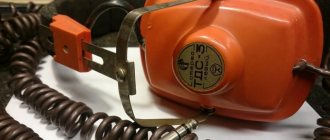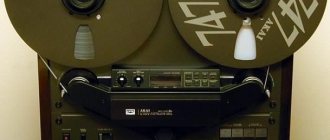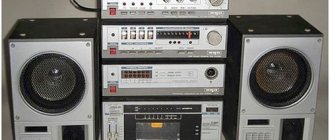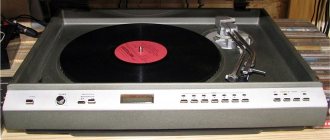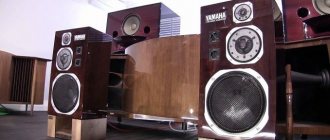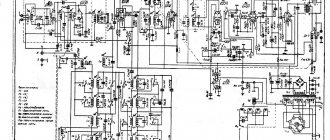Author: Yugansk
21 July 2022 20:45
Tags: USSR interesting history tape recorders photographs
11915
9
Although the market for reel-to-reel music recordings was not developed in the USSR, Hi-Fi enthusiasts had a strong passion for re-recording branded records and reels. True, high-quality Soviet-made bobbins were quite expensive - the price of top models exceeded 1000 rubles, and they were not affordable for everyone. This selection, of course, does not contain everything, but some of the best examples of the Soviet “reel” industry.
1.
Mayak-001
0
See all photos in the gallery
The famous Mayak-001-stereo was produced by Kievsky since 1973; it was a serious machine with speeds of 19.05 and 9.53 cm/sec, as well as remote control of all operating modes of the tape drive mechanism. Recording and playback levels could be monitored using dial indicators; the frequency range at a speed of 19.05 cm/sec was from 31.5 to 20,000 Hz. The model weighed 20 kg. in 1980, after modernization, the tape recorder received a quality mark.
2.
Spring
Vesna brand tape recorders were one of the most popular cassette players. The Vesna lineup began with portable reel-to-reel devices and ended with stationary stereo systems. Is it worth talking about the versatility of this technique?
“Vesna” tape recorders began to be produced in the early 60s. More than 30 years of glorious existence ended in the late 80s, when Soviet players simply could not withstand Western competition and smoothly left the market.
"Spring" was produced at several factories. The first is Kyiv, then proudly called “Communist”, and today – “Radar”. Since the 30s, this plant has changed the direction of its activities several times. In addition to the notorious tape recorders, he also worked in the aviation industry.
Today the plant successfully produces military and civilian products. Medical equipment for traumatology, LED lamps, heating boilers, and gas pressure regulators have received high praise on the world market.
The production of “Vesna” tape recorders was also carried out at the Zaporozhye plant of mobile power plants “Iskra”. This company dates back to the late 50s. Today it is included in the list of strategic objects of Ukraine and produces state-of-the-art weapons.
Electronics-007
0
The complex tape recorder was developed by Fryazinsky in 1987; the model was distinguished by the ability to program many functions using a built-in processor. They included programming playback by electronic counter or serial numbers, automatic search, the ability to review phonograms recorded on tape; the ability to correct the frequency response and bias current level depending on the type of magnetic tape. The kit also included an infrared remote control, the frequency response of the tape recorder was 20 - 25000 Hz, the device weighed 24 kg.
5.
Electronics
Elektronika tape recorders had their advantages: firstly, they could not only reproduce, but also record sounds; secondly, they were able to work autonomously, powered by batteries and car batteries, which significantly expanded the possibilities of their use.
They produced “Electronics” at Novovoronezhsky . It was founded almost immediately after the war and ended its glorious existence, like most Soviet enterprises, in the dashing 90s.
Nowadays it’s impossible to watch “Aliot” without tears.
The building of what was once a serious enterprise is now being demolished literally brick by brick, the fittings are being pulled out for scrap metal, and the surviving buildings are being rented out for retail outlets. One can only remember the past glory and pride.
Electronics TA 01-003
0
This tape recorder has been produced since 1979 by the Fryazinsky, and later by the Kirov Electrical Machine-Building Production Association named after Lepse. It had three motors and a high-quality tape transport mechanism with an automatic drive motor control system. There was also a device for electronic braking, plus a magnetic tape tension stabilization system and photoelectric auto-stop. The device also had a remote control and a built-in noise reduction system. The model weighed 27 kg.
6.
Do you have nostalgia for Soviet-made reel-to-reel tape recorders?
We invite you to a nostalgic photographic journey of 59 frames of the so-called “reel-to-reel” cameras produced in the USSR and Russia in 1986-1994. Perhaps one of our respected guests on our site would like to leave a comment about what kind of reel-to-reel tape recorder he had in the 80s and 90s, as well as which of the consoles was of the highest quality in terms of the absence of breakdowns and the purity of the sound of music ?
Opinion from the Internet: “I’ve already commented on similar topics, so I won’t talk about the subject. I thought about something else. After all, this all HAPPENED! MADE IN THE USSR! Even if you find out: who is there, who licked what from whom - to hell with him, with the invention of what was invented. But they did it! Show me today really Russian technology (do not offer Yotafon). I thought about it and discovered that I have NO Russian equipment in my house today! There is a little Soviet (a meat grinder, for example, and a frying pan - technology, aha!), and everything else is Chinese. Even if the label is European or Japanese, it is still made in China. Well, yes, my TV was assembled in Russia, but still from Chinese parts under a Korean license. Everything else, if you look into it, is the same garbage. But I know for sure that Russian technology exists. They are completing the construction of a new workshop for the needs of the defense industry (the same electronics). Everything there is very cool, take my word for it. But in stores it’s still China :(.”
Reel-to-reel stereo tape recorder “Idel-001-1”. Manufacturer: Kazan Computer Plant. Issued since 1986.
Idel - translated from the Tatar language means Volga!
Stereo reel-to-reel tape recorder “Olympus-004-stereo”. Kirov Electrical Machine-Building Production Association named after Lepse. Model 1986.
Tape recorder-attachment "Idel MPK-007S". Kazan plant of electronic computers. Model 1988 (small series).
Romantic
The first model “Romantic” appeared in the mid-60s. It was a portable transistor tape recorder. Various modifications followed. For example, “Romantic-6” was of excellent quality and was considered the most popular tape recorder in the 80s.
The final model was the Romantic-311-stereo, a two-cassette tape recorder developed in the early 90s.
The Gorky plant named after Petrovsky in Nizhny Novgorod was producing players of this brand. The company still operates today, offering various products for military, industrial and civil purposes.
In addition, the Petropavlovsk plant named after Kirov, located in Kazakhstan, was involved in the production of “Romantics”. It also retained its capacity, but, unlike Petrovsky, moved away from defense production, despite the fact that during World War II this plant was one of the main suppliers of military products.
Olympus
Perhaps the most serious of the listed equipment were reel-to-reel players of the Olympus brand. The most compelling argument is that it was on these machines that Soviet stars, who could not afford special studios, often recorded their hits.
"Olympas" were produced at the Kirov Electrical Mechanical Engineering Production Association named after. Lepse. The plant is still alive today. Moreover, it was possible to expand the scope of its production to medical, automobile, railway and oil refining products.
Yes, only memories remain of the former glory of the famous Soviet tape recorders. Unfortunately, the greatness of many of the factories that produced them has sunk into oblivion, and today only a few of them have been able to retain their name and some part of their production potential.
Reel-to-reel tape recorders
The reel-to-reel tape recorder is not just one of the sound sources, it is an entire era. You need to live in it, soak in its atmosphere, its features. For this reason, I do not understand the newly converted tape lovers who have never experienced a reel-to-reel tape recorder in their lives. Now this is a fetish, a kick in the latest fashion. What are you trying to prove by buying a Japanese tape recorder and reels for it at a price of 70 bucks? That it could theoretically sound better than an old CD (but not a modern digital recording)?
Ballfinger - a modern reel player
In my childhood everything was brighter and more beautiful. The tape recorder was a miracle, an opportunity to listen to your favorite music. As a teenager, I looked with admiration at the store window where the best Soviet high-class tape recorder Elektronika 003 (TA1-003) was on sale, costing 1,300 rubles - an annual salary. This happened in . Whether it was really sold there or whether you had to stand in line to buy it, I don’t know. By the expression “get in line” I do not mean a literal action, as it would be understood now, but an entry into a long list of sufferers, which will be implemented later for years.
It was a wonderful car with amazing performance and noise cancellation. Today this is an empty sound, but at that time a good noise reduction system (and the film hisses) simply meant nirvana for a lover of high-quality audio.
In another “branded” store, Antey, one could see another giant from the world of high-end tape recorders - Olympus 005.
Oh, what delicious characteristics it had. Reading them was the same as drinking honey:
Operating frequency range at higher speeds is 20...25000 Hz (19 cm/sec), lower speeds are 20...18000 Hz; detonation coefficient is 0.08% and 0.15%, respectively; harmonic coefficient at a speed of 19.05 cm/s 1.5%; signal-to-noise ratio at a speed of 19.05 cm/s -60, 9.53 cm/s -56 dB, power consumption from the network 100 W; dimensions of the device 460x450x220 mm; its weight is 20 kg.
You could stand at Olympus 005 and look in admiration for hours, as if it were the painting “Morning in a Pine Forest” by Shishkin. At that time, I knew the characteristics of Olympus, Elektronik, Soyuz, Iletey, Issyk-Kul by heart. The more modest 1st class Astra 110 tape recorder came into my possession much later. Before this, I briefly used a Comet 201 tube tape recorder with type 6 films (this is the kind of sandpaper that constantly tore and had to be glued with vinegar, directly with your finger). And then I spent some years with an Elfa 201 tape recorder - respectively, class 2.
How handsome he was!
With the arrival of Astra 110, that has changed. To be honest, it didn’t qualify for first class - it rattled quite loudly and was quite clumsy, but (!) it had a through channel (a high-class prerogative), and when recording on it I could hear in real time what had already been recorded a second ago, thereby reacting to contamination of the head.
The Astra was bought new in a store for an impressive 480 rubles. It was even better to choose a truly first-class tape recorder - Soyuz, but it already cost 650 rubles, which was unattainable.
I copied vinyl discs onto cassettes that I bought with friends at the philophonist club in the Rodina Cultural Center and discovered the world in a new way - Pink Floyd - The Wall, Animals, Kiss, Motorhead, Nasty Savage, AC/DC, Helloween, Led Zeppelin, Nazareth, Whitesnake etc.
Oh, tell me, what was the point, since you already had a vinyl player?
And if you don’t know the answer to this question, then it’s obvious that this topic will pass by for you, like a fetish. The records were “cut” from the player, began to crack, and sound worse over time. Tape was a luxurious option to listen to high-quality sound without the “penalty” for it.
At that time, reels and vinyl were the best choice in our country for music lovers. What can we say about other countries where everything was much more technologically advanced?
When I first saw the BASF audio reel, I was amazed at how thin the film was. And when I recorded King Diamond on it, I was shocked that the tape hissed almost 2 times quieter than any Soviet tape - Slavich or Slavutich type 11-15 (I think), not to mention the common Svema type 9.
And in the West everything was simply luxurious. This is what I want to introduce you to in the form of a photo excursion through those times.
Reel cylinder Akai X-330D
Akai reel holder with nabs - some kind of adapters for reels with large holes. For lovers of the Soviet school, this is an unusual and amazing thing.
Naby
Arrows are an invariable attribute of the reel-to-reel tape - they were used to set the level when recording.
A classic of the genre - a reel without a knob.
The dimensions and weight of reel cameras have always differed enormously.
I don’t know how you can not gasp at such beauty!
And here is the thing without which operating a tape recorder was an unrealistic task - of course, beads. They failed - they tore, stretched, and the tape recorder stopped maintaining speed.
And in Japan they chose the Pioneers, just to wear a red tie.
And these are the reels of tape themselves. Please note - the length of the tape is 1100 meters, instead of the usual 525. Although they were of different sizes abroad, and half a kilometer too.
Excuse me, is this a tape recorder, or a spaceship control panel? Don't you read the instructions? I sympathize with you from the bottom of my heart.
And this is another thing that was constantly wearing out and the sound began to lose high frequencies, becoming muddy and dull - of course, the magnetic head.
Sendust, glass ferrite, etc. I swapped the heads on my Astra for glass ferrite and plunged into music lover nirvana - glass is much more difficult to erase than iron.
The head block for the Teac tape recorder is now quite expensive.
More examples of recording reels.
And again beauty - the eyes rest for a minute:
Uuuuu...
This is how it was from the inside - isn’t it difficult? This is not a budget CD player with a tray and a toy motor.
And below is a photo of a Sony tape recorder made in 1962.
Well, okay, we have a tape recorder, and we recorded it from something, but was it like that abroad?
Of course not. Concerts there were released on reels with enough film only for this concert and it looked like this:
In conclusion of this medley and “gallops across Europe” I will say that even today I have a Soviet-made reel-to-reel tape recorder - a top-class device, Electronics 004, but in my system it is more a symbol of the old way of thinking than a source.
